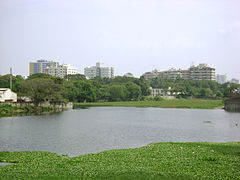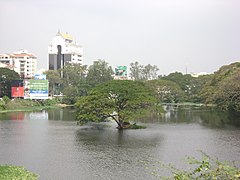
Marina Beach is a natural urban beach in Chennai, Tamil Nadu, India, along the Bay of Bengal. The beach runs from near Fort St. George in the north to Foreshore Estate in the south, a distance of 6.0 km (3.7 mi), making it the longest natural urban beach in the country. The Marina is primarily sandy, unlike the short, rocky formations that make up the Juhu Beach in Mumbai. The average width of the beach is 300 m (980 ft) and the width at the widest stretch is 437 m (1,434 ft). Bathing and swimming at the Marina Beach are legally prohibited because of the dangers, as the undercurrent is very turbulent. It is one of the most crowded beaches in the country and attracts about 30,000 visitors a day during weekdays and 50,000 visitors a day during the weekends and on holidays. During summer months, about 15,000 to 20,000 people visit the beach daily.

The Buckingham Canal is a 796 kilometres (494.6 mi) long fresh water navigation canal, that parallels the Coromandel Coast of South India from Kakinada City in the East Godavari district of Andhra Pradesh to Viluppuram District in Tamil Nadu. The canal connects most of the natural backwaters along the coast to Chennai (Madras) port.
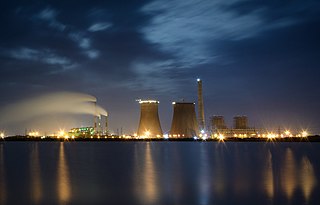
Thoothukudi, is a port city, a municipal corporation and an industrial city in Thoothukudi district in the Indian state of Tamil Nadu. The city lies in the Coromandel Coast of Bay of Bengal. Thoothukudi is the capital and headquarters of Thoothukudi district. It is located about 590 kilometres southwest of Chennai, 190 kilometres northeast of Thiruvananthapuram and 580 kilometres southeast of Bengaluru. According to Confederation of Indian Industry, Thoothukudi has the second highest Human Development Index in Tamil Nadu next to Chennai. Thoothukudi City serves as the headquarters of Tamilnad Mercantile Bank Limited. Major educational establishments in the city include Government Thoothukudi Medical College, Fisheries College and Research Institute, Tamil Nadu Maritime Academy, V.O. Chidambaram College, Kamaraj College, Anna University and Government Polytechnic College. V. O. Chidambaranar Port Trust is one of the fastest growing Major Ports in India. Thoothukudi is an "Emerging Energy and Industrial hub of South India".

Pulicat Lagoon is the second largest brackish water lagoon in India, after Chilika Lake. Pulicat Lagoon is considered to be the second largest brackish water body in India measuring 759 square kilometres (293 sq mi). The lagoon is one of the three important wetlands to attract northeast monsoon rain clouds during the October to December season in the Tirupati Region. The lagoon comprises the following regions, which adds up 759 square kilometres (293 sq mi) according to Andhra Pradesh Forest Department: 1) Pulicat Lake 2) Marshy/Wetland Land Region (AP) 3) Venadu Reserve Forest (AP) 4) Pernadu Reserve Forest (AP) The lagoon was cut across in the middle by the Sriharikota Link Road, which divided the water body into lagoon and marshy land. The lagoon encompasses the Pulicat Lake Bird Sanctuary. The barrier island of Sriharikota separates the lagoon from the Bay of Bengal and is home to the Satish Dhawan Space Centre. Major part of the lagoon comes under Nellore district of Andhra Pradesh.

Avadi is a neighbourhood of Chennai, India. It is a municipal corporation in the Chennai Metropolitan Area and 15th city corporation in Tamil Nadu. The neighbourhood lies to the west of Chennai, about 22 kilometres (14 mi) west of Chennai Central Railway Station. It is surrounded by major defence establishments and is home to various universities and engineering colleges. The neighbourhood is served by Avadi Railway Station of the Chennai Suburban Railway. As of 2011, Avadi had a population of 345,996. It is home to the Heavy Vehicles Factory (HVF), Ordnance Factory Board (ODF) which houses Engine Factory and Combat Vehicles Research and Development Establishment (CVRDE). It is one of the most populous and developed areas in Western Suburbs of Chennai.

The Chennai Municipal Corporation, is the civic body that governs the city of Chennai, India. Inaugurated on 29 September 1688, under a Royal Charter issued by King James II on 30 December 1687 as the Corporation of Madras, it is the oldest municipal body of the Commonwealth of Nations outside Great Britain. It is among the oldest municipalities in Asia after Daman Municipality, which was established in 1588. It is headed by a mayor, who presides over 200 councillors each of whom represents one of the 200 wards of the city. It is the second oldest city civic body in the world after the City of London.
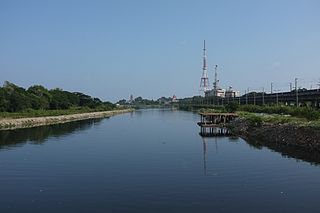
The Cooum river is one of the shortest classified rivers draining into the Bay of Bengal. This river is about 72 km in length, flowing 32 km in the city of Chennai and the rest in rural part. The river is highly polluted in the urban area (Chennai). Along with the Adyar River running parallel to the south and the Kosasthalaiyar River, the river trifurcates the city of Chennai and separates Northern Chennai from Central Chennai.

Chetpet is Located in Chennai district, Tamil Nadu. "Chetpet" is a locality in the Indian city of Chennai It is served by Chetpet railway station in the Beach-Tambaram line of Chennai Suburban Railway. Chetpet has a pond between the Chetpet railway station and the Poonamallee High Road, one of the last surviving natural water bodies in the city. It is the locality in Chennai where the mathematician Ramanujan died.

Tholkappia Poonga or Adyar Eco Park is an ecological park set up by the Government of Tamil Nadu in the Adyar estuary area of Chennai, India. According to the government, the project, conceived based on the master plan for the restoration of the vegetation of the freshwater ecosystems of the Coromandel Coast, especially the fragile ecosystem of the Adyar estuary and creek, was expected to cost around ₹ 1,000 million which will include the beautification of 358 acres of land. The park's ecosystem consists of tropical dense evergreen forest, predominantly comprising trees and shrubs that have thick dark green foliage throughout the year, with over 160 woody species, and comprises six vegetative elements such as trees, shrubs, lianas, epiphytes, herbs and tuberous species. The park was opened to public by Chief Minister M. Karunanidhi on 22 January 2011 and named after the renowned Tamil scholar Tholkappiar. About 65 percent of the park is covered by water and artefacts and signages. In the first 2 months of its inauguration, nearly 4,000 children from several schools in the city and the nearby Kancheepuram and Tiruvallur districts have visited the park to learn about wetland conservation, eco-restoration and water management. While the first phase of the ecopark covered about 4.16 acres of CRZ-III area, the entire area covered under the second phase falls under this category.

Chennai is located at 13.04°N 80.17°E on the southeast coast of India and in the northeast corner of Tamil Nadu. It is located on a flat coastal plain known as the Eastern Coastal Plains. The city has an average elevation of 6 metres (20 ft), its highest point being 60 m (200 ft).

Fishing in India is a major industry employing 14.5 million people. India ranks second in aquaculture and third in fisheries production. Fisheries contributes to 1.07% of the Total GDP of India. According to the National Fisheries Development Board the Fisheries Industry generates an export earnings of Rs 334.41 billion. Centrally sponsored schemes will increase exports by Rs 1 lakh crore in FY25. 65,000 fishermen have been trained under these schemes since year 2017 to year 2020. Freshwater consists 55% of total fish production.

Velachery aeri, or Velachery lake, is one of the lakes inside Chennai, in the Indian state of Tamil Nadu, with a good stock of water all through the year. Since Velachery is a low-lying area, the monsoon rain water from the neighbouring areas are drained into this lake. CHENNAI: In an unexpected turn of events, the Chennai Corporation has decided to put on hold the proposal for boat rides and other tourist facilities on the Velachery lake, one of the few water bodies still alive in the city. The reason it has cited is the high level of contamination of the water.

Madhavaram Milk Colony is a neighbourhood in north of Chennai, a metropolitan city in Chennai district in the Indian state of Tamil Nadu.
The Chennai Port – Maduravoyal Expressway is a 19-kilometre (12 mi) long, six lane, elevated expressway under construction in the city of Chennai, Tamil Nadu, India. The corridor begins at Chennai Port Gate No. 10 and travels along the bank of the Cooum River till it reaches Koyambedu and along the median of NH4 thereon till it reaches Maduravoyal.
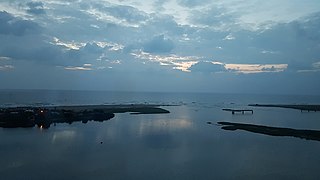
The Adyar or Adayar, originating near the Chembarambakkam Lake in Kanchipuram district, is one of the three rivers which winds through Chennai (Madras), Tamil Nadu, India, and joins the Bay of Bengal at the Adyar estuary. The 42.5-kilometre (26.4 mi) long river contributes to the estuarine ecosystem of Chennai. Despite the high pollution levels, boating and fishing take place in this river. The river collects surplus water from about 200 tanks and lakes, small streams and the rainwater drains in the city, with a combined catchment area of 860 square kilometres (331 sq mi). Most of the waste from the city is drained into this river and the Cooum.

Pallikaranai wetland is a freshwater marsh in the city of Chennai, India. It is situated adjacent to the Bay of Bengal, about 20 kilometres (12 mi) south of the city centre, and has a geographical area of 80 square kilometres (31 sq mi). Pallikaranai marshland is the only surviving wetland ecosystem of the city and is among the few and last remaining natural wetlands of South India. It is one of the 94 identified wetlands under National Wetland Conservation and Management Programme (NWCMP) operationalised by the Government of India in 1985–86 and one of the three in the state of Tamil Nadu, the other two being Point Calimere and Kazhuveli. It is also one of the prioritised wetlands of Tamil Nadu. The topography of the swamp is such that it always retains some storage, thus forming an aquatic ecosystem. A project on 'Inland Wetlands of India' commissioned by the Ministry of Environment and Forests, Government of India had prioritised Pallikaranai marsh as one of the most significant wetlands of the country. The marsh contains several rare or endangered and threatened species and acts as a forage and breeding ground for thousands of migratory birds from various places within and outside the country. The number of bird species sighted in the wetland is significantly higher than the number at Vedanthangal Bird Sanctuary.
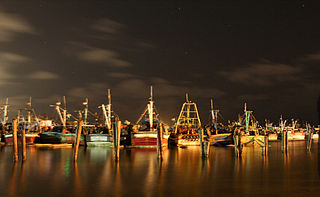
Royapuram fishing harbour, also known as Chennai fishing harbour or Kasimedu fishing harbour, is one of the major fishing grounds for catching fishes and crustaceans located at Kasimedu in the Royapuram area of Chennai, India. The harbour is located north of the Chennai Port and is under the administrative control of the Chennai Port Trust. The harbour is also a shipbuilding facility, chiefly building fishing boats. The nearest railway station is the Royapuram Railway Station.

Koyambedu Wholesale Market Complex (KWMC) is one of Asia's largest perishable goods market complex located at Koyambedu, Chennai. The market complex is spread over an area of 295 acres (1.19 km2). Inaugurated in 1996, the complex consists of about 3,100 shops, including more than 1,000 wholesale shops and 2,000 retail shops. Of these, 850 are fruit shops. It abuts the Poonamallee High Road and Nesapakkam Road. In Phase I, a wholesale market for perishables was developed in an area of around 70 acres (280,000 m2) by constructing 3,194 shops. The market has two blocks for vegetable shops and one each for fruit and flower shops. In Phase II, a textile market and in Phase III, a food grain market have been planned to be developed in the complex.
Paruthipattu Lake is a lake in Chennai, Tamil Nadu, India. It is located in the Avadi locality of Chennai. It is the second eco-park in the city after the Chetput lake.




